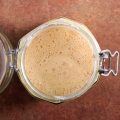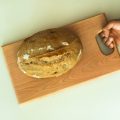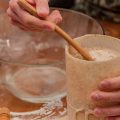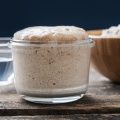Mold looming in your beloved sourdough starter? Don’t despair. Mold invasions strike fear, but armed with the right knowledge, you can conquer contamination and restore your starter’s health. This guide unpacks mold types, causes, prevention tips, and rescue techniques to vanquish mold for good. Accurately spot mold early, adjust care to inhibit future growth, and determine if a starter is salvageable or needs discarding. With this mold mastery guide, your sourdough bread will be bakery-ready once again!
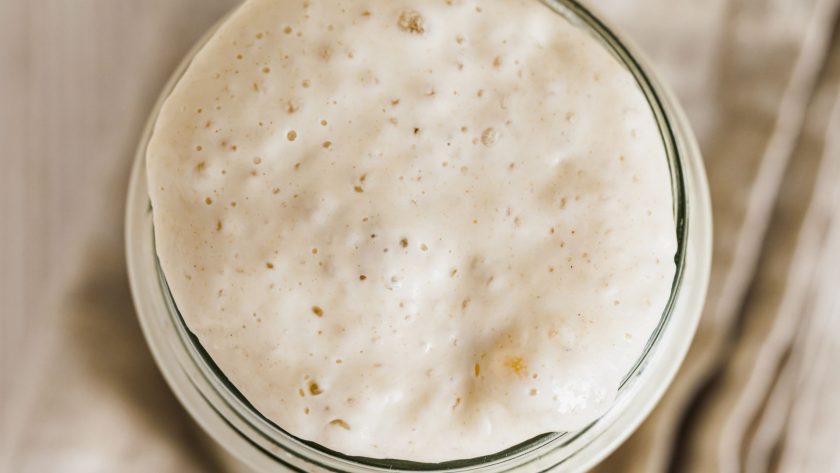
Table of Contents
- Identifying Mold in Sourdough Starters
- When To Toss Your Starter
- Causes of Mold Growth in Sourdough Starters
- Health Implications of Moldy Sourdough Starter
- Preventing Mold in Sourdough Starters
- Common Myths About Mold in Sourdough
- Salvaging a Moldy Sourdough Starter
- Alternatives to Discarded Starters
- Expert Tips for Sourdough Maintenance
- Moldy Starter? No Problem
- How to Fix Sourdough Starter Mold FAQs
Identifying Mold in Sourdough Starters
Sourdough starters are susceptible to mold growth if not properly maintained. Being able to identify mold in your starter is crucial to avoid ruining your precious sourdough and to keep it healthy for baking.
Here is a guide to detecting and identifying the most common types of mold found in sourdough starters.
Common Mold Types to Look Out For
There are a few varieties of mold that pop up frequently in sourdough starters. Being able to identify the type of mold can help you figure out how it got there and prevent future contamination.
- Black mold is one of the most harmful molds that can grow in sourdough starters. It has a dark black, velvety appearance. Black mold releases spores that can cause respiratory problems if inhaled.
- Blue or green mold is another common invader. It has a fuzzy, blue-green color and gives off a musty odor. Blue-green molds produce airborne spores that can trigger allergic reactions.
- Pink yeast is not technically a mold but is often mistaken for one. It has a pink, powdery appearance reminiscent of mold but is actually a strain of yeast. It gives off a fruity, sweet smell. Pink yeast is generally harmless.
- White mold has a fuzzy white appearance and produces a sour, rotting smell. It is less harmful than black mold but can ruin the flavor and rise of your starter.
Signs of Mold
Being familiar with the visual and aromatic properties of these common molds will help you identify an issue early before it takes over your starter.
Trust all your senses – inspect visually, take a whiff, and use your intuition. If something seems off, assume mold could be present.
Visual Signs of Mold
The most obvious indicator of mold contamination in a sourdough starter is visible mold growth. This appears as fuzzy splotches or strands on the surface of the starter. The mold can be white, black, blue, green or gray in color. The texture is often described as velvety or powdery. If you see anything resembling hairy or furry spots, webbing, or unusual discoloration this is a clear sign of mold.
In addition to color and texture changes on the surface, mold can create air pockets or a Swiss cheese-like appearance within the starter. It may also lead to an excess of liquid or a watery layer on top of the starter. These are other visual cues that mold may be present.
Smells that Signal Mold
Along with visible signs, sourdough starters contaminated with mold will give off unusual odors. The most common bad sourdough starter smells are:
- Musty, earthy smell (similar to old, damp cloth)
- Sharp sour, rotting smell
- Ammonia-like smell
- Cheesy or rancid smell
These types of unpleasant odors are not typical of a healthy sourdough starter. Familiarity with the normal smell of your sourdough starter is crucial. Any significant change in its usual scent, particularly if it becomes off-putting or strange, should be a cause for concern.
Trust your nose – if your starter smells funny or off, if you catch an unpleasant aroma, mold may be the culprit.
When To Toss Your Starter
Minor mold growth can sometimes be remedied, but extensive mold contamination requires throwing out the starter and beginning again with a fresh batch. If the mold growth covers more than 25% of the surface area, err on the side of caution and start over. Likewise, if you see air pockets or a Swiss cheese texture below the surface, this indicates the mold is established throughout the starter. Also toss if the starter has a strongly foul, rotten smell.
With quick identification and action, minor mold invasions can be conquered. But substantial mold requires a fresh start to ensure you bake up the best loaf. Trust your senses, identify the type of mold, and know when to toss and begin again. With vigilance, you can keep your sourdough starter mold-free.
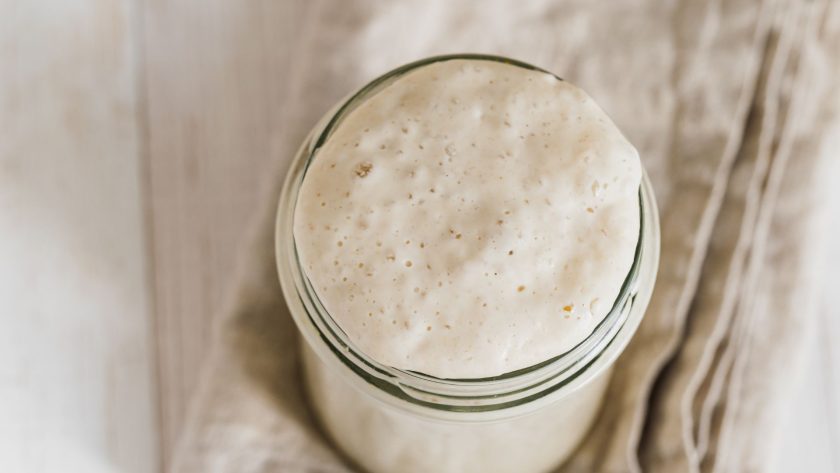
Causes of Mold Growth in Sourdough Starters
Mold invasions don’t happen spontaneously – certain missteps in caring for your sourdough starter can create prime conditions for mold to take hold and spread. By understanding what causes mold growth, you can make the adjustments needed to keep your starter healthy and mold-free.
Improper Storage Containers
The container you choose to store your starter in can unwittingly encourage mold growth. Porous materials like wood, or jars with scratches or cracks, allow mold spores to nestle in and propagate. Storing starter in the wrong types of vessels includes:
- Wooden bowls or boxes – These are porous and can harbor mold spores even after washing.
- Plastic containers with scratches – Cuts in the plastic give mold spores crevices to take root.
- Canning jars with rubber gaskets – The rubber seals can develop microscopic tears that let airborne mold in.
- Metal containers – These conduct heat and cold, leading to temperature fluctuations.
Opt for a glass, stainless steel, or food-grade plastic container that is smooth, nonporous, and free of cracks or scratches. This eliminates ideal mold homes.
Temperature Extremes
Temperature plays a key role in mold growth. Storing your starter in areas that get either too cold or too hot gives mold an environment it thrives in. Frigid temperatures below 55°F slow fermentation enough for molds to gain a foothold. High temperatures above 85°F make the starter more acidic and vulnerable to invaders.
Keep your starter at room temperature between 68-78°F for peak fermentation and mold resistance. Avoid drafty areas or places near heating/cooling vents where temperature varies. The fridge inhibits mold but also slows starter activity – reserve refrigeration only for long-term storage between bakes.
Infrequent Feedings
Mold loves neglected starters! Yeast needs regular feedings to thrive, produce acids, and fend off contamination. Feed at least once a week at room temperature, or daily if increasing starter activity. Use equal parts water and flour by weight – too much water yields a runny starter mold can permeate. Let it double in size between feedings.
Neglecting feedings leaves starter watery, acidic, and full of starch mold feasts on. A consistently fed and active starter is your best defense against mold.
Excessive Air Exposure
Every time you uncover your starter, airborne mold spores can land on the surface. Limiting air exposure reduces this risk. After feedings or removals, replace the lid immediately. Use a jar with a well-fitted lid to seal out mold spores.
When possible, avoid uncovering the starter. To check activity, peer through clear glass or plastic instead of fully removing the lid. Keep handling and air contact to a minimum to deny mold access.
High Humidity Environments
Mold thrives in dampness – a humid environment accelerates mold growth. Avoid kitchens or other areas with routinely high humidity above 60%. Store starters away from moist areas near sinks or dishwashers.
Low humidity below 40% also dries starters out rapidly, damaging fermentation. Ideal humidity for preventing mold is around 50-55%. Consider a dehumidifier if your kitchen’s humidity is persistently above 60%.
Residual Food Bits
When adding ingredients to your starter, errant food bits can get left behind. Stray crumbs or leftover pulp cling to the sides of the container, eventually decaying and providing a breeding ground for mold.
To avoid this, thoroughly scrape down the sides of your jar when mixing your starter. Remove any stuck-on bits before recovering. Also wash containers periodically in hot, soapy water to eliminate hidden food debris mold can feed on.
Health Implications of Moldy Sourdough Starter
Mold contamination in a sourdough starter should not be taken lightly. Certain molds can pose health risks if consumed or inhaled from the starter. Being aware of the potential health implications allows you to take proper precautions when dealing with a moldy starter.
Respiratory Hazards
Some molds release spores that can irritate respiratory health when inhaled. Black mold is a key offender, releasing tiny spores that easily aerosolize when disturbed. Mold spores act as allergens and inflame airways. Those with asthma or allergies may react more severely.
Wear a protective mask when disposing of moldy starter to avoid breathing in hazardous spores. Ventilate kitchens well.
Gastrointestinal Distress
Consuming moldy starter can lead to gastrointestinal issues due to mycotoxins. Mycotoxins are toxic byproducts of mold metabolism that contaminate food sources like sourdough. The severity depends on the individual and amount ingested. Those with compromised immune systems are at higher risk.
Never eat moldy sourdough or dough made with contaminated starter. Properly discard affected starters to remove gastrointestinal risks.
Allergic Reactions
Those with allergies or sensitivities to molds may experience more acute allergic reactions from exposure. For those with confirmed mold allergies, handle moldy starters with extreme caution and consult a doctor on proper precautions.
While risk depends on the individual and extent of exposure, mold should not be dismissed as completely harmless. Remember to tune in to any adverse symptoms that may signal mold-related health effects. Put your wellness first by being informed and proactive when mold invades your sourdough starter.
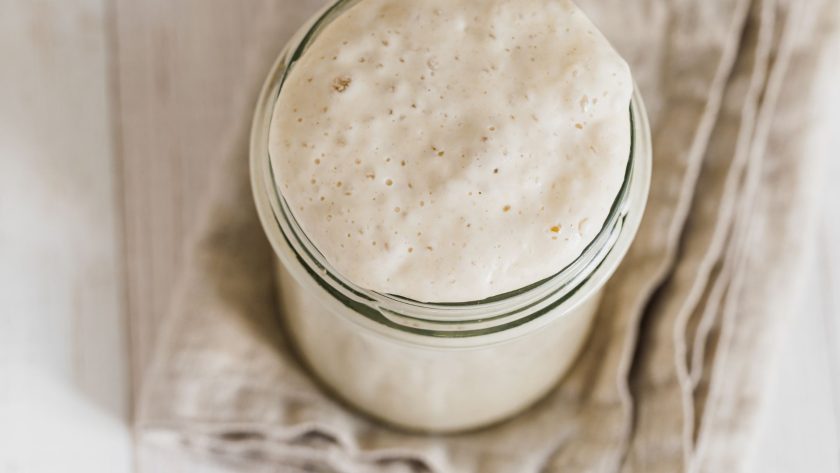
Preventing Mold in Sourdough Starters
An ounce of prevention is worth a pound of cure when it comes to keeping mold at bay in your sourdough starter. Adopting best practices in handling and storing your starter can dramatically reduce the risk of mold taking hold.
Here are proactive tips for mold prevention.
Choose the Right Container
Select a storage container that doesn’t enable mold growth. Opt for glass or plastic containers that are rigid, nonporous, and free of scratches. Avoid wood, as it harbors mold spores even after washing. Ensure the lid fits tightly to seal out airborne spores. Consider a clear jar to easily inspect the starter.
Clean containers thoroughly with hot, soapy water after each use. This prevents food residue from accumulating and decaying into a mold feast.
Control the Climate
Temperature and humidity are key factors in mold growth. Store your starter at room temperature between 68-78°F, away from drafty windows or heating/cooling vents that cause fluctuations. Kitchen humidity should remain around 50-55% to discourage mold without overly drying out the starter.
Consider using a dehumidifier if your kitchen runs persistently humid. And avoid leaving the starter near moist areas around the sink and dishwasher.
Feed Consistently
A consistently fed and active starter has a lower pH and natural defenses against invaders like mold. Feed at least weekly at room temperature using equal parts flour and water by weight. Let it double in size between feedings.
If you won’t bake for an extended period, you can slow fermentation by chilling the starter. But continue weekly feedings to prevent mold from taking advantage of neglect.
Limit Air Exposure
Every time you open the lid, you risk airborne mold spores landing on the starter. Only open when necessary, and immediately re-cover after feeding or removing starter. Resist temptation to peek! View through clear containers instead.
When mixing, scrape down the sides of the container to incorporate any stray bits where mold could take root. Then promptly replace the lid.
Sanitize Equipment
Ensure all utensils, bowls, and other equipment used with your starter are thoroughly cleaned and sanitized. Bleach solution helps eliminate mold spores that may transfer to your starter and lead to contamination.
Check Frequently
Early detection is key to conquering mold invasions. Inspect your starter daily when actively fermenting at room temperature. Look for any odd colors, weird textures, or an unpleasant aroma that could indicate mold. Catching it early makes mold easier to remedy.
Common Myths About Mold in Sourdough
With mold being a notorious invader of sourdough starters, there are plenty of myths and misconceptions floating around. Knowing the facts allows you to separate fiction from truth when it comes to mold.
Here are some common sourdough mold myths debunked.
Myth: All Mold is Dangerous
Fact: While certain molds like black mold are more hazardous, most common sourdough molds are benign.
Blue, green, and white molds mainly damage flavor and texture rather than posing a very serious health risk. Still, it’s smart to discard moldy sourdough, but no need to panic.
Myth: Mold Spores are Invisible
Fact: Mold spores are microscopic but not invisible to the naked eye. At certain growth stages, they manifest as visible mold colonies in various fuzzy colors and textures. So mold is not lurking unseen – if you don’t see obvious mold, it’s likely not there.
Myth: Discoloration Means Mold
Fact: Sourdough starters naturally change color as they ferment and age. Darkening bread dough is also normal. These natural color shifts don’t necessarily signal mold. Only fuzzy growth indicates mold.
Myth: Pink Yeast Isn’t Mold
Fact: Pink yeast resembles mold with its powdery rose color but is actually a strain of yeast called Rhodotorula. It’s harmless in sourdough, unlike true mold. So no need to discard pink yeast!
Myth: Moldy Sourdough is Always Ruined
Fact: If the mold covers less than 25% of the starter, you can simply scrape it off and revive the rest by feeding consistently at room temperature for a few days. Severe mold requires discarding, but light mold can be conquered.
Myth: Starters Improve With Age
Fact: Mature sourdough starters are not necessarily better – age increases the risk of contamination. Mold is more likely in neglected, old starters. Maintain all starters equally through regular feedings, not just your oldest one!
Myth: Freezing Kills Mold
Fact: Freezing stops mold growth but does not kill existing mold. Spores revive when thawed. Since mold can hide unseen within starters, freezing is not a solution for mold removal. Prevent it instead.
Myth: Metal Containers Prevent Mold
Fact: While metal doesn’t harbor mold spores, it conducts temperature fluctuations that encourage mold. Glass, plastic, or ceramic with a well-fitted lid makes the ideal mold-resistant vessel for starters.
Myth: Alcohol Kills Mold
Fact: A splash of vodka may help extended fridge storage, but cannot kill established mold within starters. Discard extensively moldy starters rather than wasting time and alcohol trying to save them.
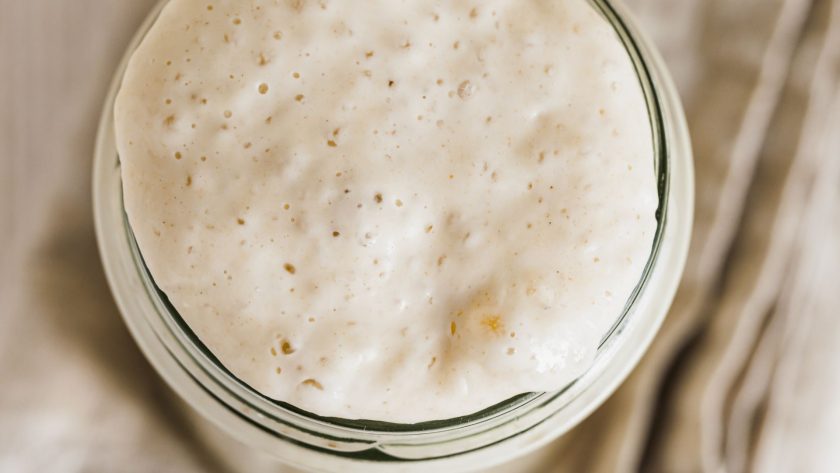
Salvaging a Moldy Sourdough Starter
Discovering mold in your sourdough starter can be disheartening. But depending on the severity, it is sometimes possible to rescue a portion of the starter and regrow it into a healthy batch again.
Check out these tips for attempted recovery of a moldy starter.
Assess the Extent of Mold
First determine how widespread the mold invasion in your bad sourdough starter is. Minor surface mold covering less than 25% of your starter can be simply scraped off and the remaining starter revived.
However, if mold permeates over 50% of the starter volume, permeates inside, or has a foul odor, it is beyond saving and must be fully discarded.
Scrape Off Surface Mold
For minor surface mold, carefully scrape off the mold with a clean utensil. Scoop beneath the mold to remove a layer underneath also, along with any discolored starter surrounding the mold. Discard the mold and this surrounding starter – do not keep any visibly contaminated portions.
Transfer and Feed the Remainder
Place the scraped and scooped starter remnants into a clean starter jar. Discard the original container, as scratches and crevices could harbor mold spores. Feed this starter remnant with equal parts flour and water, and leave uncovered at room temp.
Refresh with New Starter
Consider mixing a small amount of fresh, uncontaminated starter into the salvaged portion. This introduces healthy yeast to help crowd out any remaining mold spores as the revived starter regrows.
Let It Double and Bubble
Over the next 5-7 days, discard half and feed the remainder daily, letting it double in size between feedings. This consistent feeding and peak activity helps inhibit mold and acidifies the starter for protection. After a week of vigorous fermentation, the starter should be revitalized.
Verify No Visible Mold
During this week-long restarting process, closely inspect for any new mold growth each time before feeding. If you spot more mold, discard all and start fresh. But if no new mold appears, you should be able to reuse the salvaged starter.
Proceed with Caution
Once revived without further mold, your starter can be maintained as usual. However, keep a close eye on it for any recurrence of contamination. Mold spores could still remain dormant within. You may need to discard and restart if mold returns.
Alternatives to Discarded Starters
When extensive mold contamination forces you to discard a beloved sourdough starter, it can feel disheartening. But many great options exist for replacing your old starter and getting back to baking delicious homemade sourdough bread.
Cultivate a New Starter
Starting a starter from scratch allows you full control over the ingredients and process. Quality filtered water and bread flour produce a healthy starter.
Follow starter recipes using equal parts flour and water by weight. Expect 5-10 days for starter maturation through consistent feedings. Monitor temperature, consistency and bubbles to track fermentation. When the starter doubles in size between feedings and passes the float test, it’s ready for bread making.
Convert a Portion of Pre-fed Dough
Instead of discarding excess pre-fed dough, convert a portion into a new starter. Simply continue feeding the reserved dough as you would a typical starter.
Within 5-7 days, the yeast in the established dough will amplify through consistent feedings, developing into an active starter culture. This skips the longer maturation stage required when starting from only flour and water.
Source from a Friend’s Starter
Obtain a bit of mature starter from a baker friend’s healthy, active culture. The small amount seeds fermentation as you grow the starter through regular feedings.
This trusts in the robustness of their time-tested starter. Verify the starter shows no signs of mold before incorporating into your new batch.
Purchase a Commercial Starter
High-quality commercial starters offer convenience when you need to replace a discarded starter quickly. Specialty bakeries sell mature liquid starters ready for bread baking.
Look for starters made with quality ingredients and no preservatives or additives. Follow package instructions as you transition the commercial starter into your routine.
Dehydrate a Starter Backup
Prepare for emergencies like mold by dehydrating spare starter into a backup supply. When needed, rehydrate the powdered starter to create a new active culture.
Store dried starter in an airtight clean container in the freezer to extend shelf life. Activate only the amount needed for sourdough bread baking to limit waste.
Expert Tips for Sourdough Maintenance
Caring for a healthy sourdough starter requires vigilance and proper technique. It feels like mild neglect or not enough food automatically means harmful bacteria and a bad sourdough starter.
Here’s some advice from professionals on how to properly maintain your sourdough starter.
- Feed your starter at least weekly at room temperature with equal weights flour and water. More frequent feedings improve flavor.
- Make sure the container has a tight fitting lid. Limit opening to reduce contamination risk.
- Discard then feed starter once it doubles in size, to keep yeast active and shadows small.
- If not baking regularly, you can refrigerate and feed starter weekly. Return to room temperature a day before baking.
- Acidity deters mold – a sign of peak acidity is when starter floats in water after feeding.
- Avoid high-protein flours, which inhibit fermentation. Use all-purpose or bread flours.
- Filtered water is preferable to tap water for starter health.
- Look for starter bubbles and a pleasant, fruity aroma. Irregular odors may signal contamination.
- Temperature control is crucial – ideally 68°F to 78°F avoids fluctuations that stress yeast.
- Consistency in care regimen leads to a stable microbiome that resists invaders.
- If starter isn’t doubling daily, step up feedings to twice a day until active again.
- Scrape down sides of container when stirring to remove bits mold can grow on.
- Use glass or food-grade plastic containers – avoid porous materials like wood.
- Keep a backup starter in the fridge in case primary starter fails. Feed backup weekly.
- Trust your intuition – discard starter if anything seems off in smell, look or activity.
These specialized tips will help you care for a healthy, vigorous sourdough starter and avoid common pitfalls.
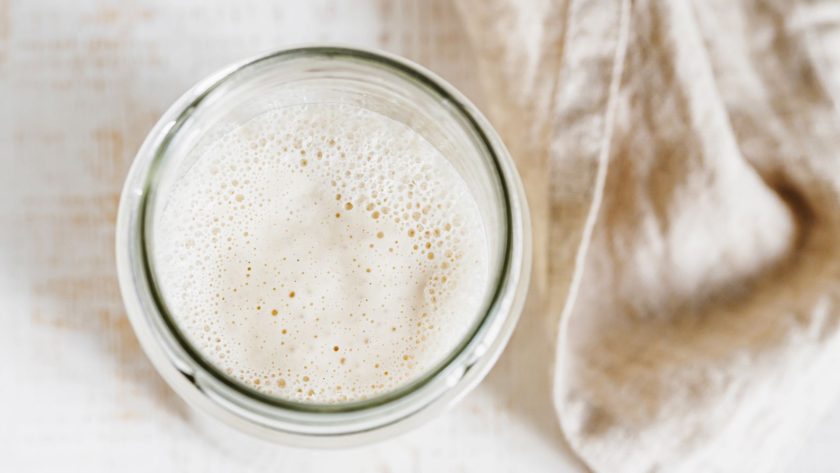
Moldy Starter? No Problem
Mold in sourdough starters can be daunting, but hopefully you can now confront it head on. While mold can attack even the best cared for starters, you now have an arsenal of knowledge to outsmart it. Identify mold types accurately, tweak your starter care to prevent growth, and rescue salvageable starters. Don’t make sourdough bread recipes with a moldy starer; best advice is to throw out moldy old starter and start anew!
With vigilance and preventive care, your sourdough bread will be mold-free and bakery-ready for countless loaves to come.
Try making sourdough recipes today!
How to Fix Sourdough Starter Mold FAQs
Why Did My Sourdough Starter Get Moldy?
The most common cause of mold on the sourdough starter is cross-contamination, from food or soap residue.
How Do You Keep Mold Out Of Sourdough Starter?
If you find that your sourdough starter developed mold, then here are some ways to prevent this: Change your flour, feed your starter regularly, and ensure that your hands, utensils, and surface is clean before feeding. Prevent mold by taking wise safety measures.
What Does Moldy Sourdough Starter Look Like?
Mold is typically fuzzy, and can have an orange or pinkish tinge.
How Do You Get Mold Out of a Sourdough Starter From a Jar?
Unfortunately, if you find that there is mold in your jar of sourdough starter, you will need to toss the entire thing out. Throw out discard from the same starter, too. Thoroughly clean your jar, before starting fresh.
Can You Use Sourdough Starter With Mold?
No, you should not use a sourdough starter that has mold.

